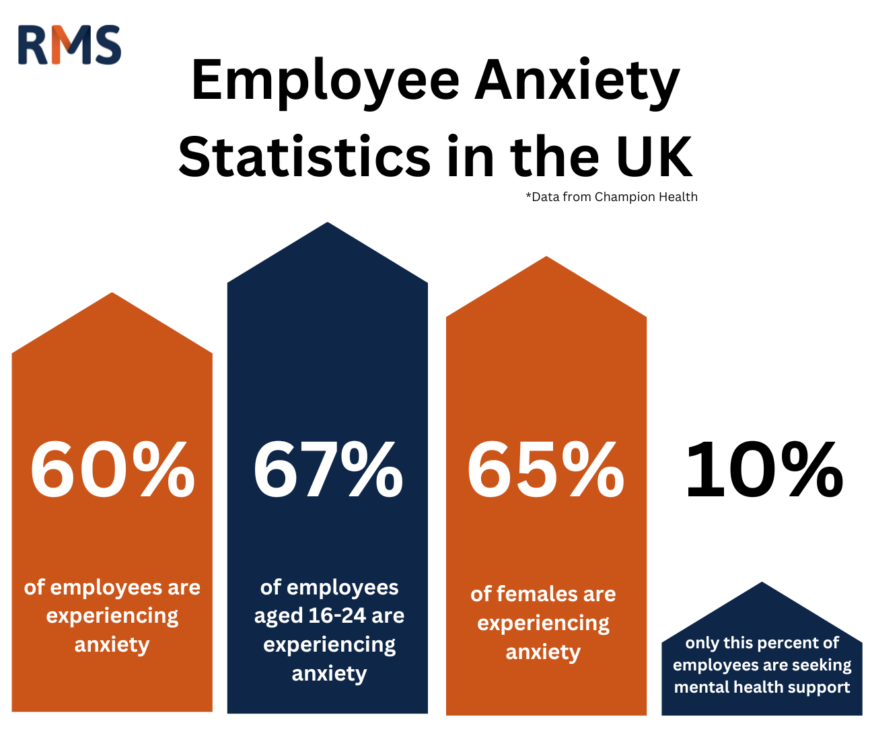There has been an “explosion” in anxiety across Britain over the last decade, according to research, but just how prevalent is it really? To learn more, we’re going to look at the data and explore anxiety statistics in the UK.
Anxiety is a future-oriented state of mind, characterised by feelings of fear, worry or general unease. Everyone feels anxious from time to time, but for some, their anxiety is constant and affects their daily lives.
Exploring UK anxiety statistics reveals how many people need support, and the extent to which different demographics are affected by anxiety.
The research shows that:
- In any given week in England, 6 in 100 people will be diagnosed with generalised anxiety disorder (Mind)
- In the UK, over 8 million people are experiencing an anxiety disorder at any one time (Mental Health UK)
- An estimated 822,000 workers are affected by work-related stress, depression or anxiety every year (Health and Safety Executive)
With so many employees experiencing anxiety, organisations must also be aware of how anxiety will impact their people’s wellbeing.
Experts at Champion Health revealed the impact of anxiety on UK employees in The Workplace Health Report. The result was a range of employee anxiety statistics which highlighted, among other things, these four key findings:
- 60% of employees are experiencing anxiety
- 67% of employees aged 16-24 are experiencing anxiety
- 65% of females are experiencing anxiety
- Only 10% of employees are seeking mental health support
1. Symptoms of anxiety are prevalent among UK employees
Champion’s data found that, across the board, the number of employees experiencing symptoms of anxiety remains high; 58% of employees are experiencing at least mild symptoms of anxiety.
Almost a quarter of employees are also experiencing ‘clinically relevant symptoms’, suggesting that they would benefit from a qualified medical health professional.
2. Younger employees are being affected more by anxiety
Champion’s research also revealed that younger employees are more likely to experience anxiety compared to their older colleagues.
For employees aged between 16-24, 67% reported experiencing symptoms of anxiety.
Employees aged between 25 and 34 were the next most affected group, with 66% of the age range reporting symptoms of mild-to-severe anxiety.
These findings take on greater significance when considered alongside research by Deloitte, which suggested that pandemic-related worries, such as job security and the resulting financial pressure, are more likely to impact younger employees.
3. Levels of anxiety are higher among female employees
Champion’s research also revealed that female employees are more likely to experience symptoms of anxiety than male employees. Almost two-thirds of women are experiencing anxiety.
More research by Deloitte may point to the reasons for this pattern. Their findings indicate that female professionals have fared poorer throughout the pandemic, due to factors such as increased workloads and household responsibilities.
The discrepancies between different employee demographics highlights the need for leaders to recognise the different pressures faced by different employees and commit to addressing them.
4. Employees aren’t seeking mental health support
Despite the prevalence of anxiety and depression among UK professionals, Champion’s data also revealed a reluctance around employees to engage with mental health support.
Just 1 in 10 employees are currently seeking support for their mental health, including counselling, talking therapies and medication. This is despite 19% reporting a current mental health diagnosis.
These statistics highlight the importance of employers being proactive about employee mental health, to get their people the right help at the right time.
It’s essential that people managers can spot the signs of struggling employees and provide them with the appropriate reasonable adjustments.
Anxiety statistics: painting a concerning picture
The statistics outlined in this article highlight the scale of the public health challenge posed by anxiety, and the key role employers must play in meeting that challenge.
With nearly 60% of employees experiencing symptoms of anxiety, proactively managing employee mental health must be at the forefront of any successful workplace health strategy.
There are many ways that leaders can support employees with anxiety says expert Phil Wake, including:
- Bringing up mental health in 1:1s and staff appraisals
- Taking steps to reduce workplace stress
- Signposting towards internal wellbeing offerings and external support services
Uncertainty may be a normal part of life, but with rates of anxiety increasing across the UK, we must all do more to support our colleagues, friends and family, today on World Mental Health Day, and the whole year round.



